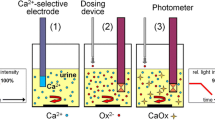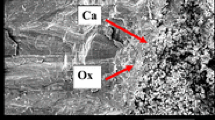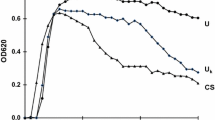Summary
The inhibitory activity of urine on calcium oxalate crystallization was measured as an inhibitory index using a gel model modified from Schneider et al. [8]. Urine samples from 36 recurrent stone formers and 21 controls in 3 separate periods (morning, afternoon and evening) were tested. Mean inhibitory indices of >0 were observed among normal controls in the 3 sampled periods and among stone formers in the morning and afternoon samples. A significantly lower (negative) value was observed in the evening samples of stone formers, indicating a higher tendency towards crystallization than normal. The gel method may be applied to identify individuals at risk of stone formation if sufficient numbers of period-defined urine samples from the individual are tested for a statistically significant mean inhibitory index but whether this is practical in a clinical laboratory will need further evaluations.
Similar content being viewed by others
References
Bowyer RC, Brockis JG, McCulloch RK (1979) Glycosaminoglycans as inhibitors of calcium oxalate crystal growth and aggregation. Clin Chim Acta 95:23–28
Drach GW, Kraljevich Z, Randolph AD (1982) Effects of high molecular weight urinary macromolecules on crystallization of calcium oxalate dihydrate. J Urol 127:805–810
Howard JE, Thomas WC Jr, Barker LM, Smith LH, Wadkins CL (1967) The recognition and isolation from urine and serum of a peptide inhibitor to calcification. John Hopkins Med J 120:119 to 136
Li MK, Lau JLT, Wong KK (1985) The pattern of urinary excretion of calcium and oxalate in normal and patients with recurrent stones. Southeast Asian J Surg, 8:68–71
Newton DJ, Scott JE, Ahmad S (1979) Circadian rhythms and the urinary excretion of acid glycosaminoglycans in normal human adults. Connective Tissue Res 7:47–55
Robertson WG (1976) Physical chemical aspects of calcium stone formation in the urinary tract. In: Fleisch H, Robertson WG, Smith LH, Vahlensiek W (eds) Urolithiasis research. Plenum Press, New York, pp 25–39
Robertson WG, Peacock M, Heyburn PJ, Marshall DH, Clark PB (1978) Risk factors in calcium stone disease of the urinary tract. Br J Urol 50:449–454
Schneider HJ, Bother W, Berg RH, Jakob M (1983) A gel model for measuring crystallization inhibitor activities. Urol Int 38:33–38
Shum DKY, Baylis C, Scott JE (1984) A micropuncture and renal clearance study in the rat of the urinary excretion of heparin, chondroitin sulphate, and metabolic breakdown products of connective tissue proteoglycan. Clin Sci 67:205–212
Author information
Authors and Affiliations
Rights and permissions
About this article
Cite this article
Li, M.K., Shum, D.K.Y. & Choi, S. Detection of crystallization inhibitory activity of whole urine with a gel model. Urol. Res. 15, 75–77 (1987). https://doi.org/10.1007/BF00260936
Accepted:
Issue Date:
DOI: https://doi.org/10.1007/BF00260936




